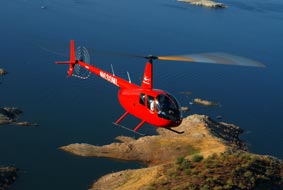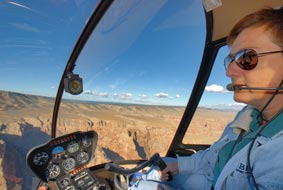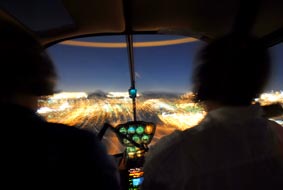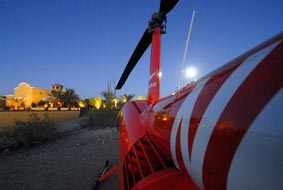The best photos of an aircraft usually show it flying.
Sunday morning, I flew in formation with another aircraft for the purpose of air-to-air photography for the fourth time.
I’ll never forget my first time.
The first time I did this was back in 2002. Flying M Air had a 1999 Robinson R22 Beta II helicopter and I wanted some air-to-air photos for advertising material. A friend of mine had access to a Piper Cub and we made arrangements to do the flight early one morning on the east side of Vulture Peak here in Wickenburg.
The friend — who, unfortunately, is no longer a friend — is an accomplished airplane pilot. He can pretty much fly anything with wings bolted on, from sailplanes to Piper Cubs to Boeing 747s. He had a lot of formation flying experience and he insisted on a briefing. The briefing was, well, brief. It consisted of the following information, which was drilled into my head by repetition:
The lead plane leads. The wing plane watches the lead.
In other words, in every formation flight, there’s a lead plane. That’s the one that sets the flight path. The other planes are wing planes. Their job is to watch the lead plane and maintain the formation. In fact, the wing plane should look at only one thing: the lead plane. The lead is responsible for keeping an eye out for traffic, making radio calls, and doing everything else. The wing follows the lead.
“What does the wing do?” he asked me?
“Follow the lead,” I replied dutifully.
This was pretty simple stuff, but I could tell that it was very important to him. And although I felt that he was treating me like a child with all the drilling, I had a feeling that he’d flown with other people who hadn’t understood the simple instructions. He wanted to make sure I understood. I did.
 We flew out of Wickenburg Airport early one morning just after sunrise, when the air was still and cool. Mike flew as a passenger in the Cub with my old digital camera. We flew several passes on the east side of Vulture Peak. Sometimes the Cub lead, sometimes I lead. The best photo of the bunch, which you see here, was with me flying wing at the Cub’s 4 o’clock position.
We flew out of Wickenburg Airport early one morning just after sunrise, when the air was still and cool. Mike flew as a passenger in the Cub with my old digital camera. We flew several passes on the east side of Vulture Peak. Sometimes the Cub lead, sometimes I lead. The best photo of the bunch, which you see here, was with me flying wing at the Cub’s 4 o’clock position.
Next, Two Helicopters
A few years later, I made arrangements with my friend Tristan to lease his 2000 R44 Raven I helicopter for a winter season. When Tristan delivered it, I figured I’d take the opportunity to get a few air-to-air shots. We did a little briefing at the airport and took off. Mike took the camera and sat beside me in my R22.
 The flight wasn’t as structured as the first flight, but it turned out okay. We got some good photos of Tristan around Vulture Peak. I trusted Tristan not to do anything crazy, but there was a certain level of stress as we flew around. I felt a constant need to see where he was because I wasn’t convinced that he understood the whole wing follows lead thing.
The flight wasn’t as structured as the first flight, but it turned out okay. We got some good photos of Tristan around Vulture Peak. I trusted Tristan not to do anything crazy, but there was a certain level of stress as we flew around. I felt a constant need to see where he was because I wasn’t convinced that he understood the whole wing follows lead thing.
Then, A Real Scare
When I got my 2005 Robinson Raven II, I needed new photos. So I asked my friend Jim if he’d fly with me. Jim’s got a Hughes 500c.
I tried to do a briefing. I really did. Jim kept telling me that he understood. I thought he did.
But as we flew, I realized that Jim didn’t give a damn about the wing follows lead thing. He was just going to fly along with me so Mike could take photos.
 Part of the problem was that Jim sits on the left side in his helicopter and I sit on the right. So when he was flying on my left side, he was mostly in my blind spot and he had difficulty seeing me. And since I thought he’d be watching me, I wasn’t watching him. Until I happened to glance over and see him a little too close for comfort on my left, right after Mike snapped this photo. To say this wigged me out is an understatement.
Part of the problem was that Jim sits on the left side in his helicopter and I sit on the right. So when he was flying on my left side, he was mostly in my blind spot and he had difficulty seeing me. And since I thought he’d be watching me, I wasn’t watching him. Until I happened to glance over and see him a little too close for comfort on my left, right after Mike snapped this photo. To say this wigged me out is an understatement.
Sunday
On Sunday morning, I flew in formation with Dave so aviation Jon Davison could get air-to-air photos of my helicopter for his upcoming book about Robinson Helicopters. Dave is a responsible pilot — heck, he sells aviation insurance for a living! He also might just have as many hours flying helicopters as I do, since he flies his helicopter from Wickenburg to Scottsdale and back — a 30-minute flight each way — most days. So I felt pretty confident that he understood the importance of keeping a safe distance from each other and always knowing where the other one is.
A side note here: about a month or two ago, there was a horrific midair collision in Phoenix between two news helicopters. They went down in a fiery crash and all four on board died. Having something like this happen so close to home — especially when it involves people you know — really peaks your awareness for the dangers of flying with other aircraft. I think this was probably on Dave’s mind as well as mine.
 We took off from Wickenburg and did a slow orbit around Vulture Peak with me in the lead. Jon sat behind Dave on the left side of the helicopter, dangling his feet out the door. They flew at my 5 o’clock position. At one point, Jon asked me to stop and hover on the east side of Vulture Peak while he and Dave moved slowly around me.
We took off from Wickenburg and did a slow orbit around Vulture Peak with me in the lead. Jon sat behind Dave on the left side of the helicopter, dangling his feet out the door. They flew at my 5 o’clock position. At one point, Jon asked me to stop and hover on the east side of Vulture Peak while he and Dave moved slowly around me.
I should mention here that Zero-Mike-Lima performed flawlessly, allowing me to hold out of ground effect hovers at more than 3000 feet MSL. It wasn’t hot and it wasn’t windy and that made things a lot easier for me. But I did have full fuel and a passenger on board, putting me at about 2200 lbs (that’s 300 lbs below max gross weight).
After Vulture Peak, we broke off and started east across the desert to Lake Pleasant, with me flying in Dave’s 7 o’clock position. We decided to do some work over the Quintero Golf Course, which most people around here don’t even know exists because you can’t see it from the main road. Dave went in first to scout the area with Jon. Then they directed me into position over a pond in the middle of the golf course. It was 8 AM and there were a few golfers down there. I hovered about 300 feet AGL over the pond while Jon and Dave flew around me. We managed to get the shots we needed in only 3 minutes, then continued on to the lake.
At the lake, we flew slowly up the east shore at Dave’s 9 o’clock position. The sun was behind Dave’s helicopter, shining right on us and on the lake and mountains beyond it. We did a few shots near the marina, then broke off and headed off to the stone house.
The stone house, which I mention briefly in “Why I Don’t Share GPS Coordinates Online,” sits on a saddle overlooking Lake Pleasant. It’s a magnificent structure — or at least it would have been if it had been completed and if the vandals hadn’t destroyed much of what was there. It made a good backdrop for the photos Jon wanted to take. After hovering around in front of it — and scaring away a small herd of cattle that had been grazing on the hillside — we landed and got out for a visit. The place was in even worse condition than it had been on my last visit more than two years before.

We climbed back into our helicopters, cranked them up, and took off to a mill site Dave knew of. It turned out to be Anderson Mill on the Santo Domingo wash. We did some more air-to-air work by the remains of the mill, then broke off and flew back to Wickenburg. Over town, Jon got a few more shots of me flying, this time with Wickenburg in the background.
It was a good photo flight.
More Photo Work Done
We spent yesterday on a whirlwind tour of northern Arizona that included Prescott, Jerome, Sycamore Canyon, Howard Mesa, the Little Colorado River Gorge, Roden Crater, the Grand Falls of the Little Colorado River (not so grand yesterday), Winslow and La Posada (I love breakfast there), Meteor Crater, and Sedona. We flew with Jon’s door off so he could get glare-free photos out the helicopter. But he also took some shots of me flying, using a wide angle lens so he could get the helicopter and views beyond in the shot. Great stuff.
Jon’s still finishing up his editing of the photos he took, but I’ve been watching him work and they look great. I hope to share a few of them here shortly. And I’m sure at least one of them will become Flying M Air‘s new postcard.
Stay tuned.
By the way, you can read more about the first three photos in this piece in “Retouched Photos?“

 Air-to-Air session. Jon rode with my friend Dave in his Hughes 500c, doors off to get glare-free images of Zero-Mike-Lima. I blogged about that shoot in “
Air-to-Air session. Jon rode with my friend Dave in his Hughes 500c, doors off to get glare-free images of Zero-Mike-Lima. I blogged about that shoot in “ Half-day flight around northern Arizona. Jon’s goal was to photograph some of the places I typically fly over, as well as to get shots of me at the controls with these places in the background. We started in Wickenburg and flew north over Prescott, Mingus Mountain, Jerome, Sycamore Canyon, Howard Mesa, Little Colorado River Gorge, Roden Crater, Grand Falls of the Little Colorado River, Winslow and La Posada, Meteor Crater, and Sedona. Jon got some great shots.
Half-day flight around northern Arizona. Jon’s goal was to photograph some of the places I typically fly over, as well as to get shots of me at the controls with these places in the background. We started in Wickenburg and flew north over Prescott, Mingus Mountain, Jerome, Sycamore Canyon, Howard Mesa, Little Colorado River Gorge, Roden Crater, Grand Falls of the Little Colorado River, Winslow and La Posada, Meteor Crater, and Sedona. Jon got some great shots. Sunset/Moonlight Dinner Tour. This is one of the tours I offer in the Phoenix area, a flight to a Falcon Field (in Mesa, where we went) or Scottsdale Airport at sunset for dinner followed by a return trip in the moonlight. Jon took some interesting nighttime photos.
Sunset/Moonlight Dinner Tour. This is one of the tours I offer in the Phoenix area, a flight to a Falcon Field (in Mesa, where we went) or Scottsdale Airport at sunset for dinner followed by a return trip in the moonlight. Jon took some interesting nighttime photos. Landing at Norquist home. The Norquists have a unique hilltop home on the northeast side of Wickenburg. I flew for them about a year ago when their Realtor hosted an open house and wanted visiting Realtors to see the town from the air. They graciously allowed us to land there for a photo shoot with the house in the background. We enjoyed some wine — well, Jon and Mike did, anyway; I still had to fly — and great conversation with some really nice people. (BTW, the house is for sale.)
Landing at Norquist home. The Norquists have a unique hilltop home on the northeast side of Wickenburg. I flew for them about a year ago when their Realtor hosted an open house and wanted visiting Realtors to see the town from the air. They graciously allowed us to land there for a photo shoot with the house in the background. We enjoyed some wine — well, Jon and Mike did, anyway; I still had to fly — and great conversation with some really nice people. (BTW, the house is for sale.) We flew out of Wickenburg Airport early one morning just after sunrise, when the air was still and cool. Mike flew as a passenger in the Cub with my old digital camera. We flew several passes on the east side of Vulture Peak. Sometimes the Cub lead, sometimes I lead. The best photo of the bunch, which you see here, was with me flying wing at the Cub’s 4 o’clock position.
We flew out of Wickenburg Airport early one morning just after sunrise, when the air was still and cool. Mike flew as a passenger in the Cub with my old digital camera. We flew several passes on the east side of Vulture Peak. Sometimes the Cub lead, sometimes I lead. The best photo of the bunch, which you see here, was with me flying wing at the Cub’s 4 o’clock position. The flight wasn’t as structured as the first flight, but it turned out okay. We got some good photos of Tristan around Vulture Peak. I trusted Tristan not to do anything crazy, but there was a certain level of stress as we flew around. I felt a constant need to see where he was because I wasn’t convinced that he understood the whole wing follows lead thing.
The flight wasn’t as structured as the first flight, but it turned out okay. We got some good photos of Tristan around Vulture Peak. I trusted Tristan not to do anything crazy, but there was a certain level of stress as we flew around. I felt a constant need to see where he was because I wasn’t convinced that he understood the whole wing follows lead thing. Part of the problem was that Jim sits on the left side in his helicopter and I sit on the right. So when he was flying on my left side, he was mostly in my blind spot and he had difficulty seeing me. And since I thought he’d be watching me, I wasn’t watching him. Until I happened to glance over and see him a little too close for comfort on my left, right after Mike snapped this photo. To say this wigged me out is an understatement.
Part of the problem was that Jim sits on the left side in his helicopter and I sit on the right. So when he was flying on my left side, he was mostly in my blind spot and he had difficulty seeing me. And since I thought he’d be watching me, I wasn’t watching him. Until I happened to glance over and see him a little too close for comfort on my left, right after Mike snapped this photo. To say this wigged me out is an understatement. We took off from Wickenburg and did a slow orbit around Vulture Peak with me in the lead. Jon sat behind Dave on the left side of the helicopter, dangling his feet out the door. They flew at my 5 o’clock position. At one point, Jon asked me to stop and hover on the east side of Vulture Peak while he and Dave moved slowly around me.
We took off from Wickenburg and did a slow orbit around Vulture Peak with me in the lead. Jon sat behind Dave on the left side of the helicopter, dangling his feet out the door. They flew at my 5 o’clock position. At one point, Jon asked me to stop and hover on the east side of Vulture Peak while he and Dave moved slowly around me.
 I love Lake Powell. I think it’s one of the most beautiful places on earth. And if you think it looks great from the ground or water, you should see it from the air! But after a 4 hour flight on 4 hours of sleep today, I decided I’d had enough of the Lake. Fortunately, I’m going home tomorrow, after dropping off one of my clients in Phoenix.
I love Lake Powell. I think it’s one of the most beautiful places on earth. And if you think it looks great from the ground or water, you should see it from the air! But after a 4 hour flight on 4 hours of sleep today, I decided I’d had enough of the Lake. Fortunately, I’m going home tomorrow, after dropping off one of my clients in Phoenix. Last year my husband Mike came along for the ferry flight to Page. We stayed two nights — I fly only around sunrise and late afternoon for my clients on this gig — and departed early the next morning for Wickenburg. That’s when Mike took this shot of the Glen Canyon Dam with the morning sun casting shadows in the canyon.
Last year my husband Mike came along for the ferry flight to Page. We stayed two nights — I fly only around sunrise and late afternoon for my clients on this gig — and departed early the next morning for Wickenburg. That’s when Mike took this shot of the Glen Canyon Dam with the morning sun casting shadows in the canyon. The lake is highly controversial. The dam flooded a huge area of pristine canyon lands with many archeological sites and even a few active settlements. This land was mostly inaccessible, like so much of America’s desert wilderness. That may be why the decision to build the dam was made. Although the Sierra Club would like nothing more than to destroy the dam and drain the lake, at this point I think it’s too late. The canyon walls are stained with minerals from the water and all plant life beneath the current water level is dead. It would take hundreds, if not thousands, of years for the area to be restored to its original health and beauty. Sadly, the need for water in the desert southwest has become more important than the need for another remote wilderness. We should be thankful that the original plan to stretch a dam across the Grand Canyon was scrapped, as we could have lost that instead.
The lake is highly controversial. The dam flooded a huge area of pristine canyon lands with many archeological sites and even a few active settlements. This land was mostly inaccessible, like so much of America’s desert wilderness. That may be why the decision to build the dam was made. Although the Sierra Club would like nothing more than to destroy the dam and drain the lake, at this point I think it’s too late. The canyon walls are stained with minerals from the water and all plant life beneath the current water level is dead. It would take hundreds, if not thousands, of years for the area to be restored to its original health and beauty. Sadly, the need for water in the desert southwest has become more important than the need for another remote wilderness. We should be thankful that the original plan to stretch a dam across the Grand Canyon was scrapped, as we could have lost that instead. I think we should be satisfied with the beauty of the lake and the recreational opportunities it provides. Although most boating activity goes on in the Page area, there’s nothing so peaceful or relaxing as climbing aboard a houseboat for a week-long trip up lake, where few day-trippers venture. Exploring the side canyons by small boat or on foot gives you a sense of what it might have been like before the waters rose.
I think we should be satisfied with the beauty of the lake and the recreational opportunities it provides. Although most boating activity goes on in the Page area, there’s nothing so peaceful or relaxing as climbing aboard a houseboat for a week-long trip up lake, where few day-trippers venture. Exploring the side canyons by small boat or on foot gives you a sense of what it might have been like before the waters rose.